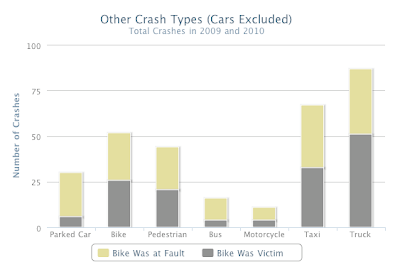If you ever need a bicycle accident attorney in San Francisco, Paso Robles, or the surrounding Central California Coast area, contact us for a free consultation.
bicycle accident attorney
Bike Boxes: Good Idea?
What Motorists Should KnowWhen the traffic signal is red, motorists must stop behind the white stop line behind the green bike box. Motorists should not stop on top of the bike box, but rather keep it clear for cyclists to use. Right turns on a red signal will not be allowed at these intersections.When the light turns green, motorists and cyclists may move through the intersection as usual, with cyclists going first. Motorists turning right on green should signal and watch for cyclists to the right.What Bicyclists Should KnowWhen a traffic signal is red, bicyclists must enter the bike box from the approaching bike lane and stop before the crosswalk.When the light is green, bicyclists should proceed as normal through the intersection. Bicyclists should be aware of right-turning motorists, especially while in the crosswalk and the intersection.
If you ever need a bicycle accident attorney in San Francisco, Paso Robles, or the surrounding Central California Coast area, contact us for a free consultation.
The People Plan
In preparation for the 2013 America’s Cup yacht race taking place on our city’s waterfront, Mayor Ed Lee is working towards improving Embarcadero’s pedestrian, bike, and transit congestion.
- Extending the F-line to Fort Mason
- Implementing a bike share program with safe parking systems
- New wayfinding signs on biking and walking routes
- Prioritizing Bike Plan projects and adding more bike lanes
These changes can really make a big difference to the waterfront, not just for the event, but permanently. If there are any changes you want to see, this is the time to suggest them. And hopefully, after the tourists have all gone home, they’ll leave behind a more commuter-friendly Embarcadero.
Bike-Friendly Candidate for Mayor
A Rising Problem In Need of a Speedier Solution
The Bay Citizen recently reported on rising bike accidents and their leading causes and locations, using data reported to the SFPD within the last two years. With helpful infographics, the article provides statistics and viewpoints both bicyclists and drivers should be aware of.
The Mission: 96 accidentsSouth of Market: 85 accidentsDowntown: 68 accidentsWestern Addition: 41 accidentsFinancial District: 34 accidentsInner Richmond: 27 accidentsCastro-Upper Market: 27 accidentsHaight-Ashbury: 22 accidentsOuter Mission: 16 accidentsNorth Beach: 15 accidentsBernal Heights: 13 accidentsLakeshore: 12 accidentsBayview: 11 accidentsOuter Sunset: 11 accidents
- Market and Octavia: 14 accidents
- Market and 5th: 14 accidents
- Market and New Montgomery: 8 accidents
- Geary and Polk: 8 accidents
- Powell and Masonic: 8 accidents


Kate McCarthy, 31, was biking up Mission Street in February 2009 when a recreational vehicle going the opposite direction made an illegal left turn right in front of her. She swerved, but still collided with the giant vehicle, crashing her bike and cutting her face. After a police officer showed up to take the report, he refused to cite the driver, even though there were several witnesses, according to McCarthy. The officer would not write up a police report assigning fault. McCarthy filed a complaint with the city’s Office of Citizen Complaints. Three months later, the body ruled that the police department should have issued a report.
While six accidents happened in 2009, eight occurred in 2010 — all of them taking place after the improvements were made. Almost every crash here is caused by cars making illegal right turns. “The more things they try there, it doesn’t really help,” said Shaana Rahman, a lawyer who has represented two cyclists in Market/Octavia crashes. “I feel like the answer is to let the cars go right and move the bike lane to a mid-bike lane.”
Redesigning the Embarcadero Promenade

Biking For the Real City Experience
In yesterday’s NYtimes, Seth Kugel gave his amusing and illuminating account of Los Angeles from the perspective of a cycling tourist.
“I had expected getting around Los Angeles by bike and public transportation to be a barely tolerable chore–a money-saving second-best way to see the city. Why, then, was I feeling so elated about my trip and smitten by a city I had never particularly liked before? […]What I had really liked were the moments in between: the strangers who shared secrets on the buses, the dog walkers and Dutch tourists who stopped to chat with me along Rodeo Drive, the aspiring actor I struck up a conversation with on Santa Monica boulevard, as he cycled to an audition and I cycled to pick up my U.C.L.A. football ticket. These were true Los Angeles moments–moments that most visitors, stuck in freeway traffic behind the steering wheel of their rental car, never get to experience.”
Electric Bikes for Beginning Cyclists
Most of us have seen in the city (if not experienced for ourselves) the spectacle of bicyclists sweating their way up a hill (Filbert, anyone?). These vertical terrors might be deterring people from biking, says a recent article in the Chronicle.
Bay Area Bike Trail Wins Federal Grant
Last Tuesday, under a program called TIGER II (Transportation Investment Generating Economic Recovery), the U.S. Department of Transportation awarded $600 million total to 70 “innovative transportation projects.”
Safer Streets to Yield More Biking
After four long years of waiting for better and safer streets, the Bike Plan injunction was finally lifted in August and cyclists in the city are already beginning to see the changes.


